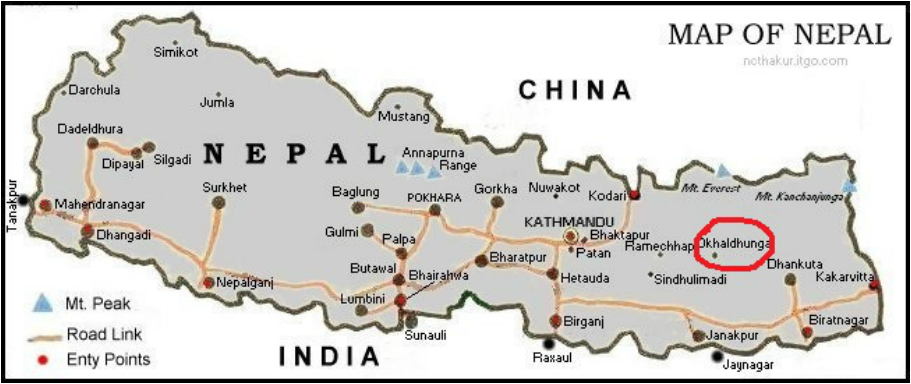Okhaldhunga District
Okhaldhunga is one of the 75 districts in Nepal. It is about 250 kilometers (175 miles) east of Kathmandu and south of Mt. Everest. It is in the Sagarmatha zone of mid-eastern Nepal. It is bordered by several large rivers including the Dudh Kosi and Sun Kosi. The months of June, July, August and September are monsoon season. Okhaldhunga gets 80% of the annual rainfall in these 4 months and it can rain up to 30" each month. Okhaldhunga is in the hill region with elevations of approximately 5,000 to 6,000 feet. The climate is mild with no snowfall, but it can get chilly at night in December and January.
PiSL has been working in three Village Development Committee (VDC) regions. VDCs are similar to a county in the USA. Each VDC has 9 wards or village groups. These villages are remote with limited or no road access. Many homes have a small government-issued solar panel, but no electricity. Most inhabitants are subsistence farmers, relying on their crops of wheat, corn, millet and legumes for food. Their plots of land are small and difficult to farm because of the steep terrain. By the end of dry season (March, April, May), water becomes scarce in some villages, making life very challenging.
Educational support from the government is limited. As a result, schools in Okhaldhunga are in disrepair and teachers are poorly trained. There is only one hospital in the entire district. For that reason, villagers often rely on traditional medicine to treat illnesses that could be easily treated by modern medicine, such as diarrhea, GI disorders and upper respiratory disorders,
The district gets its name from the Nepali word, okhal, meaning a grinding stone. A large grinding stone from the past still lies in the Okhaldhunga district headquarters. Okhaldhunga District is very scenic with beautiful terraces that are golden with wheat before the harvest. Verdant forests are found in some regions and the Himalaya mountains often peek out of the clouds.
Go to Taluwa Project, Thulachhap Project and Bhadaure Project to read about our early childhood programs in Nepal.
PiSL has been working in three Village Development Committee (VDC) regions. VDCs are similar to a county in the USA. Each VDC has 9 wards or village groups. These villages are remote with limited or no road access. Many homes have a small government-issued solar panel, but no electricity. Most inhabitants are subsistence farmers, relying on their crops of wheat, corn, millet and legumes for food. Their plots of land are small and difficult to farm because of the steep terrain. By the end of dry season (March, April, May), water becomes scarce in some villages, making life very challenging.
Educational support from the government is limited. As a result, schools in Okhaldhunga are in disrepair and teachers are poorly trained. There is only one hospital in the entire district. For that reason, villagers often rely on traditional medicine to treat illnesses that could be easily treated by modern medicine, such as diarrhea, GI disorders and upper respiratory disorders,
The district gets its name from the Nepali word, okhal, meaning a grinding stone. A large grinding stone from the past still lies in the Okhaldhunga district headquarters. Okhaldhunga District is very scenic with beautiful terraces that are golden with wheat before the harvest. Verdant forests are found in some regions and the Himalaya mountains often peek out of the clouds.
Go to Taluwa Project, Thulachhap Project and Bhadaure Project to read about our early childhood programs in Nepal.


